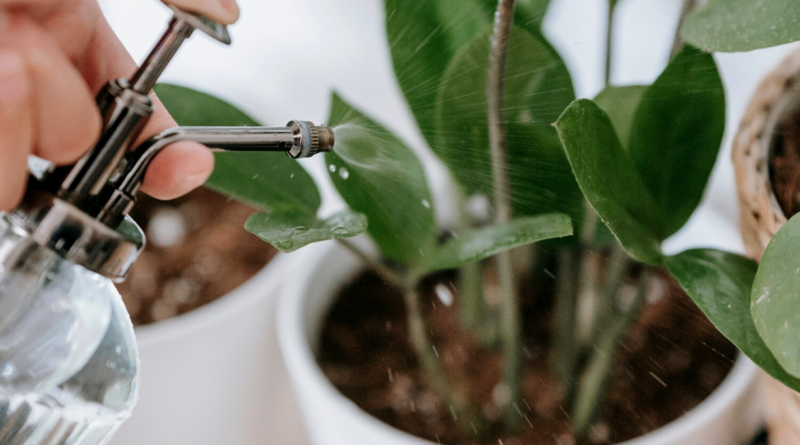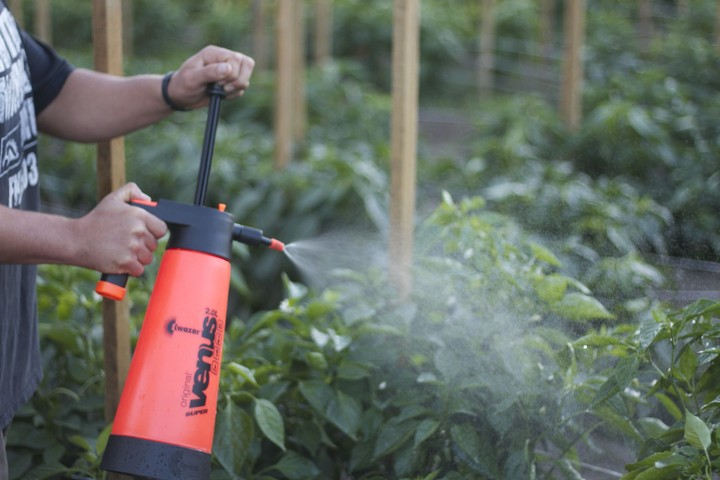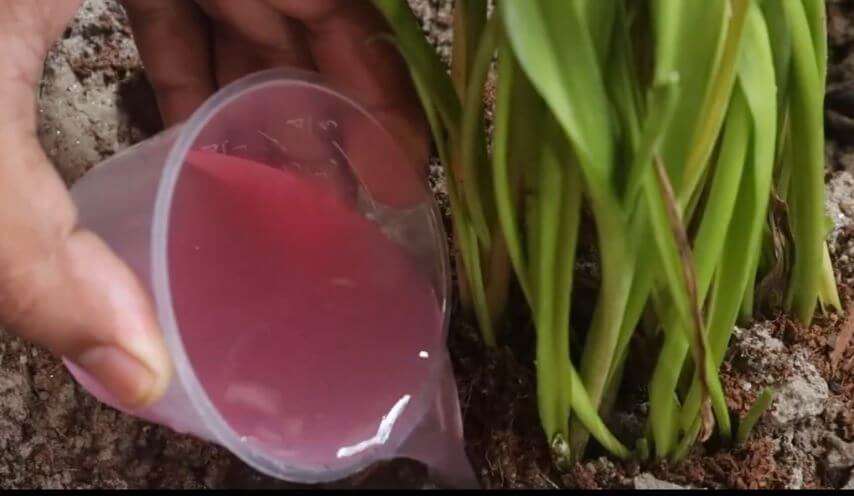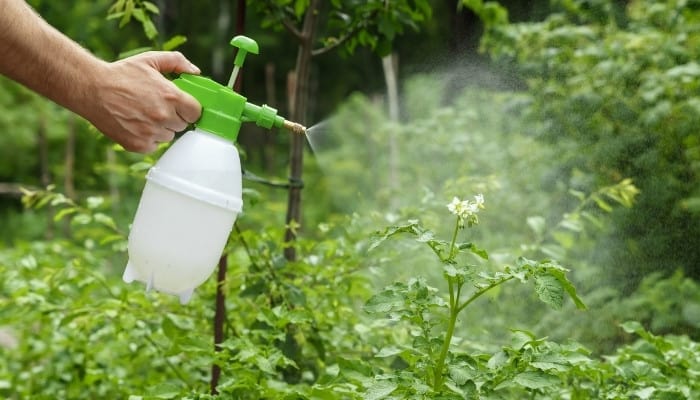Liquid fertilizers are made by mixing water-soluble nutrients like potassium chloride and anhydrous ammonia with a carrier liquid. Since the fertilizer has already been completely dissolved in the liquid, it can provide results more quickly than either dry fertilizer or granular fertilizer. Liquid fertilizer has a rapid absorption rate in the soil.
A variety of organic fertilizers, including compost, poultry manure, and cow dung produced at home, can be used to generate liquid fertilizer. In addition, inorganic fertilizers such as NPK can also be used to make this type of fertilizer.
Steps to Make Liquid Fertilizer from Dry Fertilizer

Now, you don’t have to search for how to make liquid fertilizer from dry fertilizer anywhere on the internet. We have it here for you. You can make liquid fertilizer from dry fertilizer by following these easy steps:
Step 1: Set Up Your Workspace
Make sure you have enough water in your container because you’ll need one gallon of water for every cup of fertilizer you use. Before you begin, double-check that your safety precautions, fertilizer, and stirring tools are all ready to go.
Step 2: Weigh, Measure, and Combine
A measuring cup should hold one gallon of water and one cup of fertilizer. Then, by mixing the fertilizer using a shovel, you can ensure no clumps remain and that it is completely saturated with water.
Step 3: Ensure that your Container is Covered
Remember to properly cover the container if you’re preparing liquid fertilizers using a bone meal or utilizing bone-based materials, because the smell of the fertilizer may attract insects and pests. These types of fertilizers will attract your dogs, as well as any other pets that may be present. As a result, it’s always essential to take necessary safety measures.
Step 4: Apply after Straining
Before applying your new liquid fertilizer combination for the first time, strain it to remove any remaining solids that may have remained. After 24 hours, you’ll be ready to go! Young plants can be sprayed sparingly with this solution, and the results will be visible within a few days. If you have any leftover liquid fertilizer, store it in the garage or behind the stairs; ensure that it is away from the reach of youngsters.
Steps to Convert a Dry Organic Fertilizer Mixture Into a Liquid

It’s a relatively easy process. Simply add water to your granular organic fertilizer and allow it to sit overnight before filtering out the excess water and discarding it. Organic fertilizer granules bought from a retailer can be utilized in the same way that homemade fertilizer recipes are used. The steps you need to perform are outlined in the next section.
- One cup of fertilizer should be added to every gallon of water.
- Soak the fertilizer in water for 24 hours before using it. Make sure to mix regularly.
- As a fertilizer, 1 to 2 cups of liquid per perennial, 2 to 4 cups per bush or tree, or 6 to 8 cups per tree can be applied.
- It is possible to dilute the liquid with a small amount of water and apply it as a foliar feed or spray to the plant to ensure that the root zone is completely covered. One to two tablespoons per gallon of water for potted plants, such as succulents, would be an ideal concentration.
- There is no need to throw away the solids because they still contain nutrients. Kelp meal can be used as an alternative to urea as a moderate fertilizer for established landscape plantings.
Process of Converting Homemade Dry Fertilizer into Liquid Fertilizer

A variety of organic fertilizers, including compost, poultry manure, and cow dung produced at home, can be used to generate liquid fertilizer. In addition, inorganic fertilizers such as NPK can also be used to make this type of fertilizer. This guide includes step-by-step directions for creating your own liquid fertilizer from scratch.
1. Liquid Fertilizer made from Kitchen Waste or With Compost Manure
Compost manure is a type of fertilizer made from composted food scraps and other organic household waste. It is used to fertilize crops and other plants. As a result, when manure is sprayed on plants, dogs and birds are more inclined to scavenge for nutrients in the fertilizer since it is high in nitrogen. You may be able to prevent this difficulty because the compost manure is transformed into liquid fertilizer. The following are the procedures that must be followed:
Things Needed: Compost manure, water, and bucket.
Procedure: If you simply want to fertilize a few plants, you can dilute one cup of compost manure in a gallon of water, depending on the size of your garden and the number of plants you have, to achieve the desired results.
If you’re fertilizing a modest-sized garden, you can save money by using one shovelful of compost manure instead of several gallons of the stuff. However, if you’re talking about compost manure, size does matter because it dictates how much you can use on your plants and how big of a garden you may have.
To make liquid fertilizer:
- Place a shovelful of dry compost manure in a bucket and fill the rest of the bucket with water to form a solution.
- Cover the bucket with a lid and allow it to steep for two to three days.
- Remove the tea from the container and place it in a new one after two days.
Directions to Apply:
Before feeding your garden plants, you must mix this liquid fertilizer with water in a 1:14 ratio. Then, it is possible to arrange the remaining bulbs at the base of low-maintenance plants, like shrubs, to keep them looking their best.
2. Liquid Fertilizer made from Poultry Manure
Agricultural dry fertilizers, such as poultry manure, which can be found in certain houses, offer plants a diverse variety of nutritional requirements. Detailed instructions on how to make liquid fertilizer from poultry manure are provided below:
Things Needed: Poultry manure, water, and container
Procedure: One chicken or poultry manure cup should be blended in a blender. Fill a gallon container halfway with water and add the poultry manure mixture. Separately, the gallon should be kept warm and covered. Before using the mixture, allow it to steep for two to three days. The mixture should then be strained into a new container at this point.
Directions to Apply:
This fertilizer is made by combining one part poultry manure tea with five parts water in a one-to-five ratio. Make sure to add two cups in two gallons of water, one shovel in a bucket of water, and two shovels in a bucket. Before use, the concentrated solution must be diluted with water in the right proportions. The following are the methods for producing a large quantity of poultry manure.
3. Liquid Fertilizer from Granular Inorganic Fertilizer
Granular inorganic fertilizer may be difficult for plants to absorb, whereas liquid fertilizer is considerably easier for plants to absorb, since it dissolves in water and becomes easily available to the plant’s tissues. The following is a step-by-step guide on how to make liquid fertilizer from granular inorganic fertilizers such as NPK:
Things Needed: Granular NPK fertilizer, water, and container
Procedure:
Before applying any fertilizer, carefully read the product label to understand what the fertilizer can and cannot treat, how much water to use, and where to apply the fertilizer. Take the time to become familiar with the fertilizer you are using and its chemicals. Nutrient-potentiometric fertilizer (NPK) is offered in several packing formats, such as 20/20/20 and 19:19:19.
Both of them make a positive contribution to the health and development of the plant. The three elements that make up NPK are calcium, phosphorus, and potassium. Every one of these factors is incredibly favorable to the development of plants. Fertilizers contain phosphorus, which helps to encourage the formation of secondary roots, which allow plants to penetrate the soil deeper. The development, blossoming, and fruiting phases of seeds all necessitate the consumption of potassium.
- Generally speaking, one cup of fertilizer should be used for every gallon of water.
- Soak the granular fertilizer in water for 24 hours before using it. Stir it constantly to keep it from turning lumpy and discolored.
- After a day, the liquid fertilizer can be administered to plants at a rate of 2 to 4 cups for each shrub, a cup for each perennial, and a cup for each tree, depending on the plant’s needs.
- When planting in a container, soak the entire pot in 1 to 2 cups of water per gallon of soil.
- For foliar feeding or spraying on leaves, use the product at full strength; dilute with a small amount of water to ensure that the root zones of your plants are evenly covered.
- Indoor plants, add-on plants, blooming plants, and succulents are all able to benefit from this. They will be the ones who achieve the finest results.
- You should avoid using liquid, granular NPK fertilizer if you wish to cultivate vegetables and fruits. Before you begin, make sure you have the proper fertilizer for your garden.
Directions to Apply:
Before feeding your garden plants, combine one part concentrated liquid fertilizer with four parts water in a small mixing container.
Important Liquid Fertilizer Feeding Tips

The following tips should be kept in mind when using liquid fertilizer to feed your plants:
- You need to know exactly what kind of fertilizer you’re dealing with at all times.
- Plants should never be fertilized with concentrated liquid fertilizer.
- After the fermentation process is complete, dilute the fluid to achieve the required consistency.
- Always use a dilute solution of liquid fertilizer to feed your garden plants rather than a concentrated solution of liquid fertilizer. This is to ensure that your plants receive the right amount of nutrients.
Also Read: How Long Does Fertilizer Last? Be Aware of the Expiry
Advantages of Using Liquid Fertilizer
- It is possible to maximize the benefits of each type of fertilizer by combining dry and liquid fertilizer.
- Liquid fertilizer is easier to apply than powdered fertilizer. Liquid fertilizer is also more exact than its powdered counterpart. After diluting, the components of liquid fertilizer are uniformly spread in the water, ensuring that they are all delivered in equal proportions to the soil. When watering the plants, it is possible to administer liquid fertilizer to the soil or to the foliage.
- When nutrients are delivered to plants in liquid form, they can be utilized by the plants almost immediately. As opposed to granular fertilizer, there is no need to wait for it to decay slowly over a period of time. Therefore, you should use liquid fertilizer when you wish to offer your plants a speedy boost in the growth process.
- Liquid fertilizer has the additional benefit of allowing plants to more easily obtain immobile nutrients. As soon as the liquid gets into contact with the plant’s roots or leaves, the nutrients have already been dissolved in the liquid and are available for absorption by the plant as needed.
- When it comes to storing liquid fertilizer, it’s more difficult than storing granular fertilizer since liquid fertilizer is more viscous.
Also Read: What are the Advantages of Synthetic Fertilizers?
Cons of Using Liquid Fertilizer
- The components can separate when they thaw, indicating that the product should not be frozen. If the fertilizer swells too much, it is possible that it will spill out of the container.
- Liquid fertilizer is more expensive than dry fertilizer. When compared to granular fertilizer, liquid fertilizer has a higher initial cost and needs to be applied more regularly. Feeding a large number of plants can quickly add up in terms of money spent.
Conclusion
Making liquid fertilizer at home is a convenient and cost-effective alternative to purchasing it. With only a few basic materials, you can have your garden nurtured with a delicious and nutrient-dense liquid fertilizer in as little as 24 hours. Conserve money while protecting your plants from charring and crusting. In gardens and farms, granular fertilizer can cause runoff, be transported away by irrigation, or be consumed by some pets if handled improperly.
In contrast, liquid fertilizer, which is created by dissolving granular fertilizer in water, can offer your plants the nutrients they require to survive and thrive. In some circumstances, liquid fertilizer is preferable to solid fertilizer because it is more readily available to the plant’s roots when applied to the soil. However, while liquid fertilizers are taken by plants almost instantly, granular fertilizers must be allowed to dissolve or disintegrate before they are made available to plants.
You May Also Read….
- How to Fertilize Lawn? Secret Tips You Should Follow When Fertilizing Lawn
- When to Fertilize Lawn? Important Things You Should Know Before Fertilizing Your Lawn
- 5 Best Fertilizer for Grass in Summer – {Review 2023}
- A Guide to the Best Fertilizer for Cucumbers to Buy in 2022
- Can You Apply Ironite and Fertilizer at the Same Time?
- Top 7 Best Fertilizer for Palm Tree (Review 2022)
- 6 Best Fertilizer Spreader to Buy in 2022 (Top Picks for Your Lawn)
- 6 Best Blackberry Fertilizer to Buy in 2022 (Our Top Picks)
- 7 Best Fertilizer for Plumeria in 2022
- The Pros and Cons of Organic Fertilizer Every Gardener Should Know
